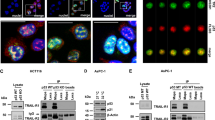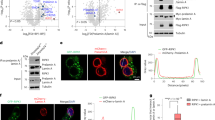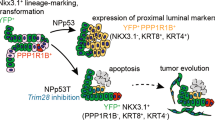Abstract
Promyelocytic leukemia (PML) nuclear bodies (PML NBs) are discrete subnuclear domains organized by the promyelocytic leukemia protein PML, a tumor suppressor essential for multiple apoptotic pathways. We have recently described a novel family of cellular factors, the THAP proteins, characterized by the presence at their amino-terminus of an evolutionary conserved putative DNA-binding motif, designated THAP domain. Here, we report that THAP1 is a novel nuclear proapoptotic factor associated with PML NBs, which potentiates both serum withdrawal- and TNFα-induced apoptosis, and interacts with prostate-apoptosis-response-4 (Par-4), a well characterized proapoptotic factor, previously linked to prostate cancer and neurodegenerative diseases. We show that endogenous Par-4 colocalizes with ectopic THAP1 within PML NBs in primary endothelial cells and fibroblasts. In addition, we found that Par-4 is a component of PML NBs in blood vessels, a major site of PML expression in vivo. Finally, we investigated the role of the THAP domain in THAP1 activities and found that this putative DNA-binding domain is not required for Par-4 binding and localization within PML NBs, but is essential for THAP1 proapoptotic activity. Together, our results provide an unexpected link between a nuclear factor of the THAP family, the proapoptotic protein Par-4 and PML nuclear bodies.
This is a preview of subscription content, access via your institution
Access options
Subscribe to this journal
Receive 50 print issues and online access
$259.00 per year
only $5.18 per issue
Buy this article
- Purchase on Springer Link
- Instant access to full article PDF
Prices may be subject to local taxes which are calculated during checkout








Similar content being viewed by others
References
Barradas M, Monjas A, Diaz-Meco MT, Serrano M and Moscat J. (1999). EMBO J., 18, 6362–6369.
Berra E, Municio MM, Sanz L, Frutos S, Diaz-Meco MT and Moscat J . (1997). Mol. Cell Biol., 17, 4346–4354.
Besset S, Vincourt JB, Amalric F and Girard JP . (2000). FASEB J., 14, 345–354.
de The H, Lavau C, Marchio A, Chomienne C, Degos L and Dejean A . (1991). Cell, 66, 675–684.
Deiss LP, Feinstein E, Berissi H, Cohen O and Kimchi A . (1995). Genes Dev., 9, 15–30.
Diaz-Meco MT, Lallena MJ, Monjas A, Frutos S and Moscat J . (1999). J. Biol. Chem., 274, 19606–19612.
Diaz-Meco MT, Municio MM, Frutos S, Sanchez P, Lozano J, Sanz L and Moscat J . (1996). Cell, 86, 777–786.
D'Orazi G, Cecchinelli B, Bruno T, Manni I, Higashimoto Y, Saito S, Gostissa M, Coen S, Marchetti A, Del Sal G, Piaggio G, Fanciulli M, Appella E and Soddu S . (2002). Nat. Cell Biol., 4, 11–19.
Ferbeyre G, de Stanchina E, Querido E, Baptiste N, Prives C and Lowe SW . (2000). Genes Dev., 14, 2015–2027.
Flenghi L, Fagioli M, Tomassoni L, Pileri S, Gambacorta M, Pacini R, Grignani F, Casini T, Ferrucci PF, Martelli MF, et al. (1995). Blood, 85, 1871–1880.
Fogal V, Gostissa M, Sandy P, Zacchi P, Sternsdorf T, Jensen K, Pandolfi PP, Will H, Schneider C and Del Sal G . (2000). EMBO J., 19, 6185–6195.
Gale Jr M, Blakely CM, Hopkins DA, Melville MW, Wambach M, Romano PR and Katze MG . (1998). Mol. Cell Biol., 18, 859–871.
Girard JP, Baekkevold ES, Feliu J P B, and Amalric F . (1999). Proc. Natl. Acad. Sci. USA, 96, 12772–12777.
Girard JP and Springer TA . (1995a). Immunity, 2, 113–123.
Girard JP and Springer TA . (1995b). Immunol. Today, 16, 449–457.
Guo Q, Fu W, Xie J, Luo H, Sells SF, Geddes JW, Bondada V, Rangnekar VM and Mattson MP . (1998). Nat. Med., 4, 957–962.
Guo A, Salomoni P, Luo J, Shih A, Zhong S, Gu W and Paolo Pandolfi P (2000). Nat. Cell Biol., 2, 730–736.
Hofmann TG, Moller A, Sirma H, Zentgraf H, Taya Y, Droge W, Will H and Schmitz ML . (2001). Nat. Cell Biol., 10, 10.
Ishov AM, Sotnikov AG, Negorev D, Vladimirova OV, Neff N, Kamitani T, Yeh ET, Strauss III JF and Maul GG . (1999). J. Cell Biol., 147, 221–234.
Johnstone RW, See RH, Sells SF, Wang J, Muthukkumar S, Englert C, Haber DA, Licht JD, Sugrue SP, Roberts T, Rangnekar VM and Shi Y . (1996). Mol. Cell Biol., 16, 6945–6956.
Kogel D, Bierbaum H, Preuss U and Scheidtmann KH . (1999). Oncogene, 18, 7212–7218.
Lallemand-Breitenbach V, Zhu J, Puvion F, Koken M, Honore N, Doubeikovsky A, Duprez E, Pandolfi PP, Puvion E, Freemont P and de The H . (2001). J. Exp. Med., 193, 1361–1372.
LaMorte VJ, Dyck JA, Ochs RL and Evans RM . (1998). Proc. Natl. Acad. Sci. USA, 95, 4991–4996.
Lee CC, Beall EL and Rio DC . (1998). EMBO J., 17, 4166–4174.
Lehembre F, Muller S, Pandolfi PP and Dejean A . (2001). Oncogene, 20, 1–9.
Li H, Leo C, Zhu J, Wu X, O'Neil J, Park EJ and Chen JD . (2000). Mol. Cell Biol., 20, 1784–1796.
Mattson MP, Duan W, Chan SL and Camandola S . (1999). J. Mol. Neurosci., 13, 17–30.
Mizushima S and Nagata S . (1990). Nucleic Acids Res., 18, 5322.
Negorev D and Maul GG . (2001). Oncogene, 20, 7234–7242.
Page G, Kogel D, Rangnekar V and Scheidtmann KH . (1999).Oncogene, 18, 7265–7273.
Pearson M, Carbone R, Sebastiani C, Cioce M, Fagioli M, Saito S, Higashimoto Y, Appella E, Minucci S, Pandolfi PP and Pelicci PG . (2000). Nature, 406, 207–210.
Qiu G, Ahmed M, Sells SF, Mohiuddin M, Weinstein MH and Rangnekar VM . (1999). Oncogene, 18, 623–631.
Quignon F, De Bels F, Koken M, Feunteun J, Ameisen JC and de The H . (1998). Nat. Genet., 20, 259–265.
Richard DJ, Schumacher V, Royer-Pokora B and Roberts SG . (2001). Genes Dev., 15, 328–339.
Roussigne M, Kossida S, Lavigne A-C, Clouaire T, Ecochard V, Glories A, Amalric F and Girard J-P . (2003). Trends Biochem. Sci., in press.
Ruggero D, Wang ZG and Pandolfi PP . (2000). Bioessays, 22, 827–835.
Sells SF, Han SS, Muthukkumar S, Maddiwar N, Johnstone R, Boghaert E, Gillis D, Liu G, Nair P, Monnig S, Collini P, Mattson MP, Sukhatme VP, Zimmer SG, Wood Jr DP, McRoberts JW, Shi Y and Rangnekar VM . (1997). Mol. Cell Biol., 17, 3823–3832.
Sells SF, Wood Jr DP, Joshi-Barve SS, Muthukumar S, Jacob RJ, Crist SA, Humphreys S and Rangnekar VM . (1994). Cell Growth Differ., 5, 457–466.
Sternsdorf T, Jensen K, Reich B and Will H . (1999). J. Biol. Chem., 274, 12555–12566.
Sternsdorf T, Jensen K and Will H . (1997). J. Cell Biol., 139, 1621–1634.
Terris B, Baldin V, Dubois S, Degott C, Flejou JF, Henin D and Dejean A . (1995). Cancer Res., 55, 1590–1597.
Torii S, Egan DA, Evans RA and Reed JC . (1999). EMBO J., 18, 6037–6049.
Wang ZG, Delva L, Gaboli M, Rivi R, Giorgio M, Cordon-Cardo C, Grosveld F and Pandolfi PP . (1998a) Science, 279, 1547–1551.
Wang ZG, Ruggero D, Ronchetti S, Zhong S, Gaboli M, Rivi R and Pandolfi PP . (1998b). Nat. Genet., 20, 266–272.
Yang X, Khosravi-Far R, Chang HY and Baltimore D . (1997). Cell, 89, 1067–1076.
Zhong S, Hu P, Ye TZ, Stan R, Ellis NA and Pandolfi PP . (1999). Oncogene, 18, 7941–7947.
Zhong S, Muller S, Ronchetti S, Freemont PS, Dejean A and Pandolfi PP . (2000a). Blood, 95, 2748–2752.
Zhong S, Salomoni P and Pandolfi PP . (2000b). Nat. Cell Biol., 2, E85E–90.
Zhong S, Salomoni P, Ronchetti S, Guo A, Ruggero D and Pandolfi PP . (2000c). J. Exp. Med., 191, 631–640.
Acknowledgements
We thank Dr H De Thé (Paris, France) and Dr A Dejean (Paris, France) for the gifts of plasmids, and Dr A Bouloumié (Toulouse, France) and Dr P Sassone-Corsi (Strasbourg, France) for kindly providing human primary endothelial cells and fibroblasts, respectively. We are grateful to Denis Jullien, Vincent Ecochard and Anne-Claire Lavigne for critical reading of the manuscript. Special thanks go to Stéphanie Boireau and others members of the Vascular Biology Laboratory (IPBS, Toulouse) for help in initial experiments and stimulating discussions. This work was supported by grants from Fondation de France, ACI ‘Jeunes chercheurs’ Ministère de la Recherche, CNRS, Région Midi-Pyrénées, and Association pour la Recherche sur le Cancer. This paper is dedicated to the memory of Jacques Féliu.
Author information
Authors and Affiliations
Corresponding author
Rights and permissions
About this article
Cite this article
Roussigne, M., Cayrol, C., Clouaire, T. et al. THAP1 is a nuclear proapoptotic factor that links prostate-apoptosis-response-4 (Par-4) to PML nuclear bodies. Oncogene 22, 2432–2442 (2003). https://doi.org/10.1038/sj.onc.1206271
Received:
Revised:
Accepted:
Published:
Issue Date:
DOI: https://doi.org/10.1038/sj.onc.1206271
Keywords
This article is cited by
-
Prostate apoptosis response-4 and tumor suppression: it’s not just about apoptosis anymore
Cell Death & Disease (2021)
-
Unraveling Molecular Mechanisms of THAP1 Missense Mutations in DYT6 Dystonia
Journal of Molecular Neuroscience (2020)
-
DNA methylation-based chromatin compartments and ChIP-seq profiles reveal transcriptional drivers of prostate carcinogenesis
Genome Medicine (2017)
-
Structural basis for the regulatory interactions of proapoptotic Par-4
Cell Death & Differentiation (2017)



